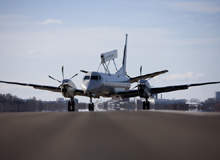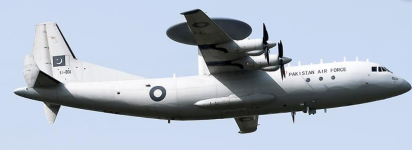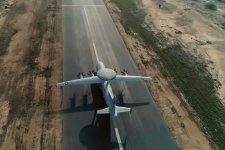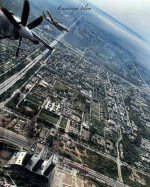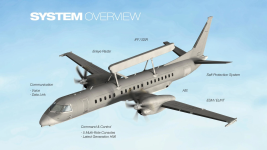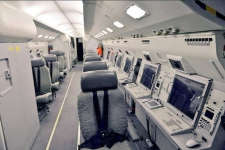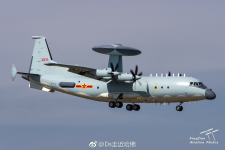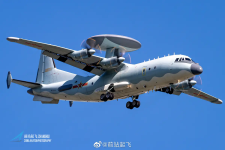Reference :
The Saab 2000 Erieye AEW&C airborne early warning and control aircraft is a variant of the Saab 2000 regional transport…

www.airforce-technology.com
The Saab 2000 Erieye AEW&C airborne early warning and control aircraft is a variant of the Saab 2000 regional transport turboprop aircraft equipped with the spine-mounted Saab Systems Erieye PS-890 side-looking reconnaissance radar.
The aircraft, fully equipped for
airborne early warning and control, can also be used for national security missions, border control, airborne command and control, disaster management coordination and for emergency air traffic control.
Saab 2000 Erieye AEW&C aircraft is in operational use in Pakistan and Saudi Arabia.
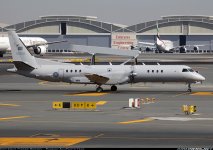
Orders and deliveries of Saab 2000 Erieye AEW&C
The first customer for the Saab 2000 AEW&C, the Pakistan Fiza’ya (the Pakistan Air Force), placed the order with Saab, based in Stockholm, in June 2006 for Skr6.9bn ($933m). The Government of Pakistan renegotiated part of the contract in May 2007 due to financial crisis within the country. The contract value was reduced to Skr1.35bn ($194m).
The first of four aircraft was rolled out in April 2008 and entered service in October 2009. The second aircraft was delivered to Pakistan in April 2010 to monitor Indian airspace. Thailand announced the selection of the Saab 2000 AEW&C in June 2007.
Saab received an Skr1.553bn ($160m) order from undisclosed customer for the Saab 2000 Erieye AEW&C aircraft in May 2020. The deliveries will be made between 2020 and 2023.
Saab 2000 AEW&C programme
Saab Surveillance Systems was the lead contractor for the Saab 2000 AEW&C programme. Saab Aerotech was responsible for the development and modification of the Saab 2000 regional aircraft to the AEW&C configuration. Six other Saab business units were also contracted for major elements of the programme.
The outer wing sections were strengthened, as has the roof of the fuselage, to accommodate the weight of the Erieye antenna and its housing. The vertical tail area was increased to provide improved stabilisation.
Main cabin
The main cabin is fitted with five mission operator consoles on the starboard side.
The windows on the starboard side of the main cabin have been removed. The cabin is air-conditioned and fitted with an active noise cancellation system.
The aft section of the main cabin accommodates fuel tanks and mission equipment. Two auxiliary fuel tanks are installed on the starboard side in the mid fuselage section immediately aft of the mission consoles.
The mission operator consoles perform system and sensor management; mission planning and simulation; track data processing; asset management and control; identification and allocation. The display systems incorporate digital maps and use high-resolution flat-panel colour displays and touch input display controls. The main cabin aft section also accommodates the electronic warfare equipment, the Erieye equipment and the Erieye power units.
Erieye surveillance radar
Saab Microwave Systems (formerly Ericsson) was the lead contractor for the Erieye surveillance radar, an active phased array pulse Doppler radar operating in the 3.1GHz to 3.3GHz band. The Erieye radar is operational on several other aircraft including the Saab 340, Embraer R-99 and Embraer EMB-145. The radar is operational from three minutes after take-off and during climb and provides an effective surveillance area of 500,000km² horizontally and 60,000ft vertically.
The Erieye radar has an instrumental range of 450km and detection range of 350km against a fighter aircraft sized target in dense hostile electronic warfare environments and at low target altitudes. The system is capable of tracking multiple air and sea target over the horizon and provides above 20km altitude coverage, 360° coverage and has sea surveillance capability. The radar incorporates an identification friend or foe interrogator. The system comprises an active phased array pulse Doppler radar with a secondary
surveillance radar.
The fixed dual sided electronically scanned antenna array is installed in a rectangular housing, dorsally mounted above the fuselage.
Electronic warfare suite
The Saab 2000 Erieye AEW&C aircraft’s electronic warfare suite is based on the Saab Avitronics HES-21 electronic support measures (ESM) and self-protection suite. The HES-21 also provides a ground-based support system (EGSS), which provides mission data for the aircraft electronic warfare system and for analysis of recorded data.
Electronic support measures
The electronic support measures (ESM) system comprises digital narrow band and wide band receivers and associated antennae, providing close to 100 % probability of intercept (POI). The digital receiver is equipped with interferometer antenna arrays.
The ESM obtains the electronic order of battle (EOB) data and intercepts, characterises and identifies signals, defines their direction of arrival, generating and displaying warning information. The system operates autonomously and allows real time ESM analysis and presentation to its operator on board the aircraft.
The radar receivers cover low band (7GHz to 2GHz), mid band (2GHz to 18GHz) and high band (28GHz to 40GHz).
The digital RF receiver provides very high sensitivity and selectivity and uses fast Fourier transforms (FFT) and channelisation signal processing techniques. The ESM’s wide band and narrow band receivers provide 360° coverage, and close to 100% probability of intercept. The system provides high sensitivity and selectivity in dense and hostile signal environments.
Self-protection system
The self-protection system (SPS) comprises defensive aids control system, radar warning, laser warning, missile approach warning and chaff and flare dispenser systems. The self-protection suite provides selection and, in automatic mode, the initiation of the chaff and countermeasures sequences.
The laser warning system is based on the Saab Avitronics LWS-310 laser warner operating in the 0.5 to 17 microns wavelength bands. Spatial and spectral coverage is provided by an array of three sensors on each side of the aircraft.
The missile launch and approach warner (MAW) is based on the Saab Avitronics MAW-300, which can simultaneously monitor and track up to eight threats. It has four sensors, two on each side, and each with 110° azimuthal coverage to provide the overlapped 360° spatial coverage.
The chaff and flare dispensing system (CFDS) comprises a dispenser control unit, (CFDC) with a cockpit mounted display and control panel, defensive aids suite computer with a threat library database, two BOL electromechanical dispensers and six BOP pyrotechnical dispensers.
The BOL dispenser is a high-capacity, 160-cartridges, electro-mechanical chaff dispenser. The BOL dispensers are installed in the fairings under the wingtip-mounted radar warning pods. The dispenser incorporates vortex generators which provide chaff blooming characteristics and a chaff cloud Doppler response.
The BOP dispenser is a pyrotechnic dispenser carrying Nato standard rectangular cartridges or magazines of 39 1in² cartridges. The dispenser has the capability to dispense different ammunition types concurrently. The BOP dispensers are housed on each side of the underside of the fuselage to the aft of the wings.
Engine
The Saab 2000 Erieye AEW&C aircraft is fitted with two Rolls-Royce AE 2100A turboprop engines developing 3,095kW. AE 2100A is a two-shaft gas turbine engine equipped with a 14-stage high pressure (HP) compressor driven by a two-stage HP turbine. The engine also features a planetary reduction gearbox connected to the propeller.
The length and diameter of the engine are 11.8in (0.29m) and 19in (0.48m) respectively.
The aircraft is installed with a full authority digital engine control (FADEC) to manage both engine and propeller.
Saab 2000 Erieye AEW&C performance
The maximum cruise and patrol speeds of the aircraft are 629km/h and 296km/h respectively. The time required by the aircraft to climb an altitude of 9,144m is 15 minutes. The range is 3,705km, take-off run of the aircraft is 1,400m, and the maximum endurance is 9.5 hours. The aircraft weighs around 14,500kg and its maximum take-off weight is 23,000kg.






